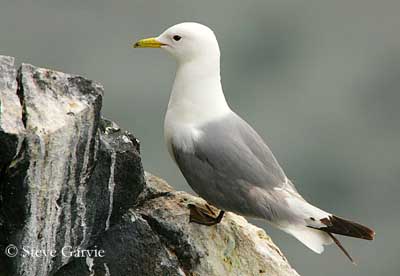
Fr: Mouette tridactyle
All : Dreizehenmöwe
Esp: Gaviota Tridáctila
Ital: Gabbiano tridattilo
Nd: Drieteenmeeuw
Sd: Tretåig mås
Photographers:
Steve Garvie
RAINBIRDER Photo galleries
Tom Grey
Tom Grey's Bird Pictures
Nicole Bouglouan
PHOTOGRAPHIC RAMBLE
Text by Nicole Bouglouan
Sources:
HANDBOOK OF THE BIRDS OF THE WORLD Volume 3 by Josep del Hoyo-Andrew Elliott-Jordi Sargatal - Lynx Edicions - ISBN : 8487334202
THE HANDBOOK OF BIRD IDENTIFICATION FOR EUROPE AND THE WESTERN PALEARCTIC by Mark Beaman, Steve Madge - C.Helm - ISBN: 0713639601
THE COMPLETE BOOK OF BRITISH BIRDS – Written by “Royal Society for the Protection of Birds” experts - Préface de Magnus Magnusson - Michael Cady- Rob Hume Editors - ISBN: 0749509112
ENCYCLOPEDIE DES OISEAUX DE FRANCE ET D’EUROPE – de Peter Hayman et Rob Hume - Flammarion – ISBN : 2082009920
Bird Web (Seattle Audubon Society)
BirdLife International (BirdLife International)
What Bird-The ultimate Bird Guide (Mitchell Waite)
Black-legged kittiwake
Rissa tridactyla
Charadriiforme Order – Laridae Family
BIOMETRICS:
Length: 38-40 cm
Wingspan: 91-97 cm
Weight: 305-510 g
DESCRIPTION:
The Black-legged Kittiwake is an elegant seabird living in huge colonies established on narrow rocky ledges on cliff faces. They are found throughout the Northern Hemisphere.
The adult in breeding plumage has blue-grey mantle and upperwing-coverts. The outer wing is paler, greyish-white, with black triangular patch at tip.
The head is white. The bill is yellow. The eyes are dark brown, surrounded by narrow red eye-ring. Legs and webbed feet are blackish.

The adult in winter plumage shows dusky grey crown and nape, but there is also a darker grey band on the hindcrown, and dark areas around the eyes.
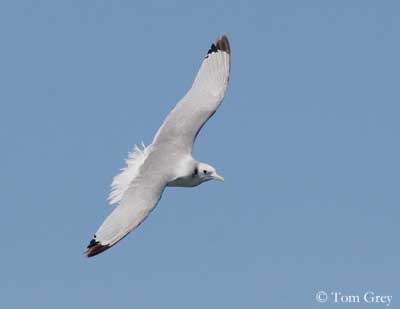
The young birds, juvenile and immature, have black zigzag pattern on the upperwing, black nape and black sub-terminal tail bar. They can breed at four years of age.
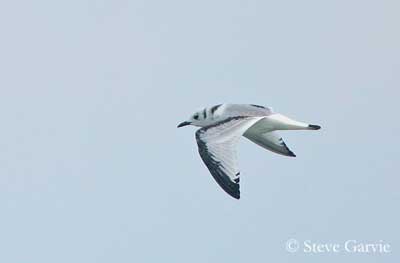

The other race, R.t. pollicaris, is larger, with larger black wing tips.
VOICE: SOUNDS BY XENO-CANTO
The Black-legged Kittiwake utters quiet mew “ock-ock-ock” and series of ringing, piercing “kitti-way-ake”.
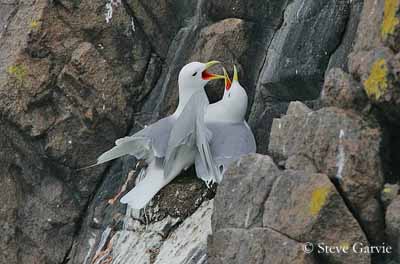
HABITAT:
The Black-legged Kittiwake frequents arctic and temperate waters. This species breeds on coasts with open water and nests on high, steep cliffs.
In Europe, it also nests on buildings, piers, and even sometimes on flat areas with rocks or sand, but always near the sea, rarely up to 20 km inland.
Outside the breeding season, this seabird is pelagic.
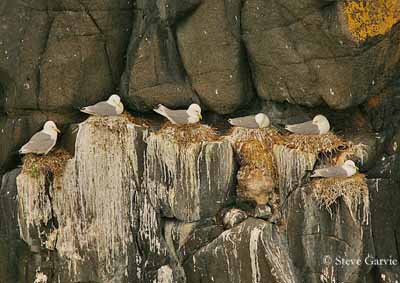
RANGE:
The Black-legged Kittiwake is found in Northern Pacific and Atlantic Oceans and Arctic waters.
The R.t. tridactyla ranges from NC Canada and NE USA, through Greenland to W and N Europe and N Russia. It winters southwards to Sargasso Sea and W Africa.
The R.t. pollicaris ranges from NE Siberia through Bering Sea to Alaska. It winters southwards to E China Sea and NW Mexico.
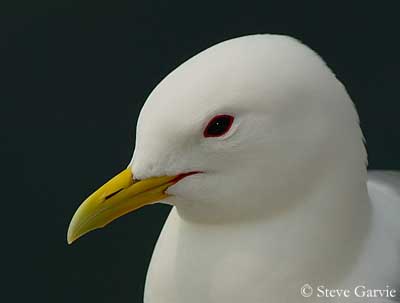
BEHAVIOUR:
The Black-legged Kittiwake feeds mainly on marine food items such as invertebrates and fish. Outside the breeding season, it takes squid, fish and shrimps. It also scavenges offal and carcasses.
It forages on intertidal areas for molluscs, crustaceans and earthworms, and can catch small mammals in the vegetation. It also consumes some plant matter such as potatoes, grain and aquatic plants.
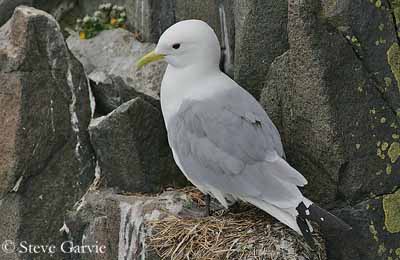
The Black-legged Kittiwake feeds by surface-dipping, sometimes with foot-pattering, and also performs plunge-diving and can reach up to one metre in depth below the surface. It also pecks at the surface.
These birds usually feed within 50 km from their colonies.
During the breeding season, they establish huge colonies on narrow cliff ledges. These colonies may contain tens of thousands of noisy birds. Each pair defends the small territory immediately around the nest.
They display at nest, walking slowly while bobbing the head, and the male performs courtship feeding to the female. The displays are accompanied by calling, and the copulation takes place on the ledge.
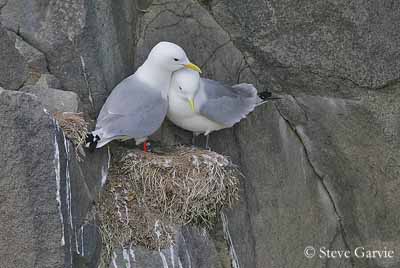
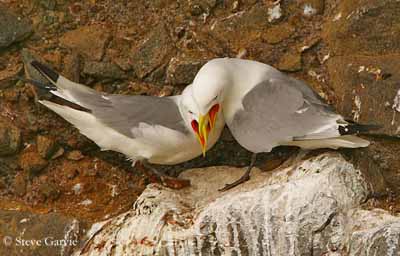
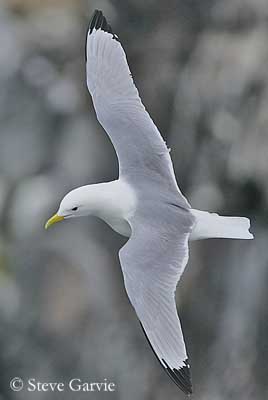
The Black-legged Kittiwake is migratory and performs post-breeding dispersal, leaving the colonies to reach open ocean. The species usually remains across N Atlantic and N Pacific Oceans in winter, where the birds gather at rich food sources. They rarely reach the tropics.
FLIGHT:
The Black-legged Kittiwake has swift graceful flight with several rapid shallow wing-beats interspersed with glides. It also hovers over water before to dive for preys.
REPRODUCTION:
The laying occurs between mid-May and mid-June, but the colonies are occupied as soon as January or February.
The nest is on narrow cliff ledge. It is made with grass and feathers.
The female lays 1-3 eggs and both parents incubate during 24-28 days. The downy chicks are white, with greyish back and wings. They remain on the ledge where they are fed by both adults, and guarded for 4 weeks. They fledge between 5 and 7 weeks after hatching.
The predation by gulls is very important, involving poor reproductive success in some parts of the breeding range.
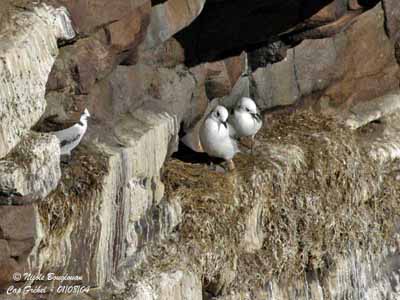
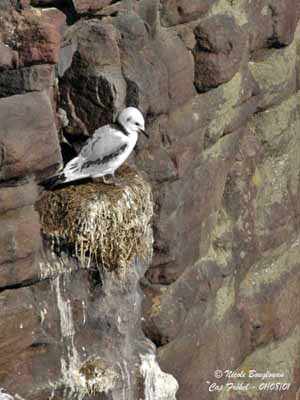
DIET:
The Black-legged Kittiwake feeds on fish, squid, shrimps, molluscs and crustaceans. It takes several fish species, using surface-dipping and plunge-diving methods.
PROTECTION/THREATS/ STATUS:
The populations of the Black-legged Kittiwake are not currently endangered. They have large range and have increased and expanded it during the 20th century.
This species is the most abundant of the family Laridae.